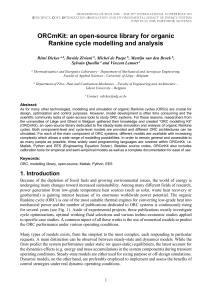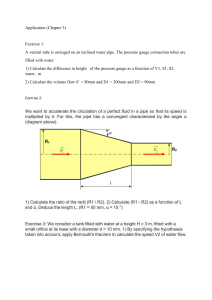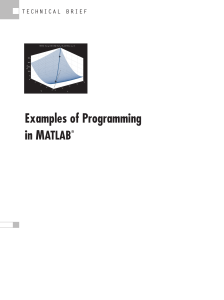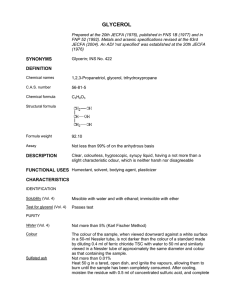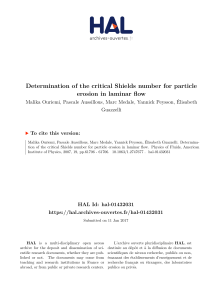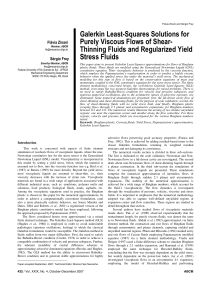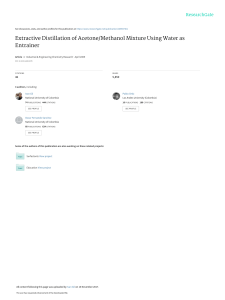1-D Simulation of Organic Rankine Cycle (1)
publicité
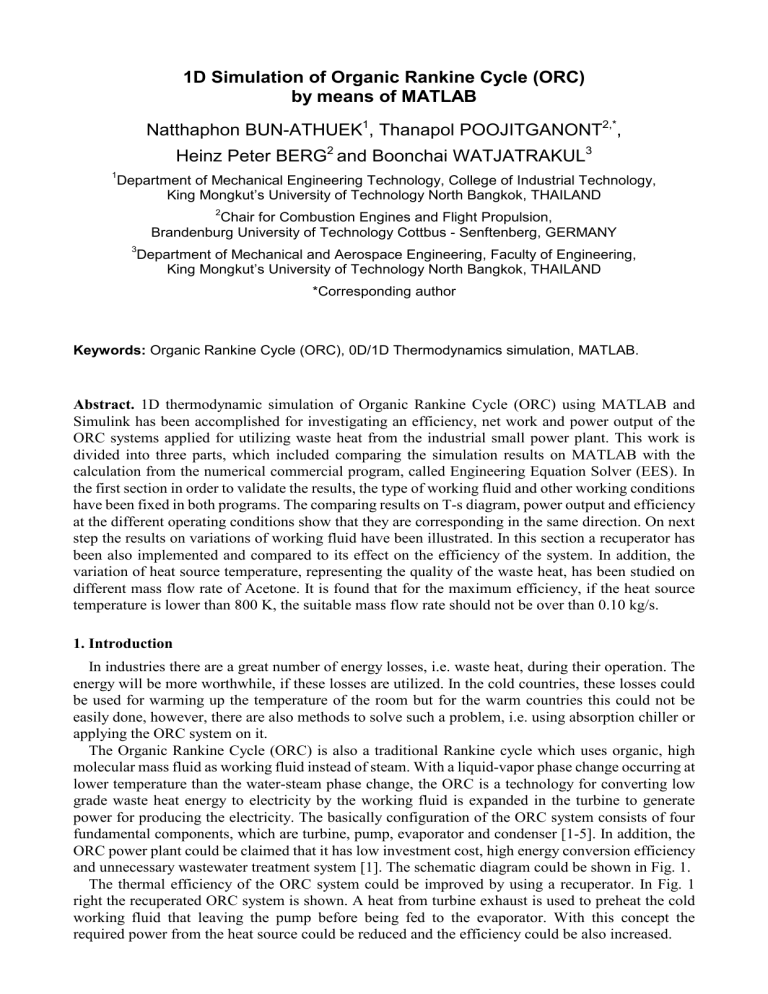
1D Simulation of Organic Rankine Cycle (ORC) by means of MATLAB Natthaphon BUN-ATHUEK1, Thanapol POOJITGANONT2,*, Heinz Peter BERG2 and Boonchai WATJATRAKUL3 1 Department of Mechanical Engineering Technology, College of Industrial Technology, King Mongkut’s University of Technology North Bangkok, THAILAND 2 Chair for Combustion Engines and Flight Propulsion, Brandenburg University of Technology Cottbus - Senftenberg, GERMANY 3 Department of Mechanical and Aerospace Engineering, Faculty of Engineering, King Mongkut’s University of Technology North Bangkok, THAILAND *Corresponding author Keywords: Organic Rankine Cycle (ORC), 0D/1D Thermodynamics simulation, MATLAB. Abstract. 1D thermodynamic simulation of Organic Rankine Cycle (ORC) using MATLAB and Simulink has been accomplished for investigating an efficiency, net work and power output of the ORC systems applied for utilizing waste heat from the industrial small power plant. This work is divided into three parts, which included comparing the simulation results on MATLAB with the calculation from the numerical commercial program, called Engineering Equation Solver (EES). In the first section in order to validate the results, the type of working fluid and other working conditions have been fixed in both programs. The comparing results on T-s diagram, power output and efficiency at the different operating conditions show that they are corresponding in the same direction. On next step the results on variations of working fluid have been illustrated. In this section a recuperator has been also implemented and compared to its effect on the efficiency of the system. In addition, the variation of heat source temperature, representing the quality of the waste heat, has been studied on different mass flow rate of Acetone. It is found that for the maximum efficiency, if the heat source temperature is lower than 800 K, the suitable mass flow rate should not be over than 0.10 kg/s. 1. Introduction In industries there are a great number of energy losses, i.e. waste heat, during their operation. The energy will be more worthwhile, if these losses are utilized. In the cold countries, these losses could be used for warming up the temperature of the room but for the warm countries this could not be easily done, however, there are also methods to solve such a problem, i.e. using absorption chiller or applying the ORC system on it. The Organic Rankine Cycle (ORC) is also a traditional Rankine cycle which uses organic, high molecular mass fluid as working fluid instead of steam. With a liquid-vapor phase change occurring at lower temperature than the water-steam phase change, the ORC is a technology for converting low grade waste heat energy to electricity by the working fluid is expanded in the turbine to generate power for producing the electricity. The basically configuration of the ORC system consists of four fundamental components, which are turbine, pump, evaporator and condenser [1-5]. In addition, the ORC power plant could be claimed that it has low investment cost, high energy conversion efficiency and unnecessary wastewater treatment system [1]. The schematic diagram could be shown in Fig. 1. The thermal efficiency of the ORC system could be improved by using a recuperator. In Fig. 1 right the recuperated ORC system is shown. A heat from turbine exhaust is used to preheat the cold working fluid that leaving the pump before being fed to the evaporator. With this concept the required power from the heat source could be reduced and the efficiency could be also increased. Recuperator Figure 1. Diagram of the ORC system without and with recuperator (left and right respectively) For analyzing the ORC process, the first law of thermodynamics is a fundamental and traditional approach to calculate the total work and thermal energy of system, including the efficiency of cycle. The equations for calculating the energy balance of each component could be given as following. Heat transfer at evaporator: Qevp = m& ORC (hevp,out − hevp,in ) (1) Wturb = m& ORC ( hturb , out − hturb ,in ) (2) Q cond = m& ORC ( hcond ,out − hcond ,in ) (3) W pump = m& ORC (h pump,out − h pump,in ) (4) Work done by turbine: Heat transfer at condenser: Work by pump: The cycle efficiency: Wturb − W pump Qevp η ORC = ×100% (5) Based on its facile and flexible, the MATLAB/Simulink is applied for calculating and analyzing the ORC process. At the beginning the CoolProp thermodynamic library of working fluids properties [6] must be installed. Then the thermodynamic equations 1 to 5 have been programmed with assumptions and boundary conditions as following. - Heat source temperature and specific heat are constant at inlet. - Each process is steady-state and adiabatic. - Friction and heat losses in the connecting pipes are neglected. - Kinetic and potential energy of the working medium are neglected. - Heat transfer is calculated from fully developed flow. - Evaporator and condenser are assumed to work at 100% efficiency. - Pinch point temperature for the condenser is 15˚C. - Pinch point temperature for the evaporator is 20˚C. - Waste heat source at evaporator inlet is 280˚C. - Specific heat of heat source is 1.1 kJ/kg-K. - Supply temperature of cooling water at condenser is 25˚C. - Isentropic efficiency of pump and turbine are 80%. 2. Methodology of Simulation 1. Validating the results from MATLAB/Simulink with EES results [2] on efficiencies and net work outputs. The working fluid is fixed as Acetone. The evaporator’s pressure varies between 5, 10, 15 and 20 bar. The expander’s temperature lies between 200 – 280˚C. And the mass flow rate of the heat source is at 0.28287 kg/s. 2. Variation of working fluid, i.e. Acetone, MM, Ethanol and Cyclopentane in different working condition as in step 1, to investigate its effects and be able to choose the suitable working fluid for each condition of ORC process. 3. Variation of heat source temperature between 127 – 2127˚C in different mass flow rate, i.e. 0.10, 0.20, 0.30 and 0.40 kg/s, of Acetone (as working fluid) to investigate the effects and characters impact to cycle efficiency of the process. 4. Implementing the recuperator on the ORC system to investigate its effects and characters impact to the cycle efficiency. 3. Results and Discussions Figure 2. T-s diagram of ORC process by MATLAB/Simulink (left) and EES (right) Figure 3. Net work calculation of ORC process by MATLAB/Simulink (left) and EES (right) Figure 4. Efficiency of ORC process by MATLAB/Simulink (left) and EES (right) The comparing results with EES are shown in Fig. 2 to 4 on T-s diagram, net work and efficiency respectively. It is evidently that results of both programs are compatible in the same direction. Then the variation of working fluid is also accomplished and illustrated in Fig. 5 and 6 on T-s diagram and efficiency, respectively of the ORC system. 1 2 3 4 Figure 5. T-s diagram of ORC process on different working fluid [1.Acetone 2.MM 3.Ethanol 4.Cyclopentane] 1 2 3 4 Figure 6. Efficiency of ORC process on different working fluid [1.Acetone 2.MM 3.Ethanol 4.Cyclopentane] At the same state of pressure when the temperature of the heat source is at 280˚C and the turbine inlet temperature (TIT) is greater than 500 K, the Ethanol is showing the best result comparing to the others, whereas in the case of TIT between 400 – 500 K, Acetone can provide the highest efficiency. Figure 7. Efficiency of ORC system on different working fluid’s mass flow rate and heat source temperature Next step the heat source temperature has been investigated on variation of working fluid’s mass flow rate. The result of efficiency versus heat source temperature is demonstrated in Fig. 7. It is found that Acetone with the mass flow rate at 0.10 kg/s provides highest efficiency on the heat source temperature between 400 – 800 K. But if the waste heat lies between 800 – 1000 K, the mass flow rate of Acetone should be increased to 0.20 kg/s instead. Figure 8. Efficiency of system with recuperator on different working fluid [1.Acetone 2.MM 3.Ethanol 4.Cyclopentane] The results of ORC system including recuperator has been illustrated in Fig. 8 on different types of working fluid. In case of the TIT is greater than 500 K, using MM as working fluid can get the best result comparing to the others. Whereas between 400 – 500 K of TIT, it is found that Acetone, Ethanol and Cyclopentane provide closely results on efficiency as well. 4. Conclusion The 1D simulation of ORC with MATLAB has been accomplished and validated with the results from the EES program. It is evidently that both results are corresponding in the same direction. On variation of working fluid for the ORC process, it is found that Ethanol is showing the best result when the heat source temperature is at 280˚C and the TIT is greater than 500 K, whereas in case of TIT between 400 – 500 K, Acetone can provide the highest efficiency. In addition, the maximum efficiency of the system will be also influenced by the mass flow rate of working fluid, when the heat source temperature has been varied. Moreover, it is also clearly that the efficiencies of all cases are increased by means of recuperator especially at low working pressure condition as well. Acknowledgement This research is supported by the DAAD “Praxispartnerschaften zwischen Hochschulen und Unternehmen in Deutschland und in Entwicklungsländern - Cooperative Development of Micro-Turbines for Developing Countries” program, and the etop Co., Ltd. References [1] Natthaporn Chaiyard, Organic Rankine Cycle power plant prototype, Handout of Engineering, School of Renewable Energy, Mae-Jo University, Chiang Mai, Thailand.(In THAI) [2] Rajender Reddy Gujjula, Feasibility Analysis of Organic Rankine Cycle for SOFC-MGT Hybrid System with Exhaust Gas Waste Heat Recovery, Master Thesis, BTU-CS, Germany, 2015. [3] Yunus A. Cengel and Michel A. Boles, Thermodynamics an Engineering Approach Fourth Edition in SI Unit, McGrawHill company, Inc., New York. [4] Sylvain Quoilin, An introduction to thermodynamics applied to Organic Rankine Cycles, S.T.G International, November 2008 [5] S. Poles, M. Venturin, Numerical Simulation of an Organic Rankine Cycle, Open Source Engineering report. [6] Information on http://www.coolprop.org/coolprop/wrappers/MATLAB/index.html#matlab
